
|
October 25, 2006: A moment with...
(Photo COURTESY MALCOLM BELL ’63 *72) |
Malcolm Bell ’63 *72
Malcolm Bell III ’63 *72, a professor of art history at the University of Virginia and the Archaeological Institute of America’s vice president for professional responsibilities, is a leading advocate for the repatriation of ancient artifacts to the countries from which they were taken. Bell, who is also co-director of the Morgantina excavations in Sicily, a project initiated by Princeton archaeologists in 1955, recently discussed the proper home for ancient artifacts with PAW’s Mark F. Bernstein ’83.
Is repatriation a new issue in archaeology?
It has been an issue for a long time, but it was dramatized last year by the trial in Rome of Robert Hecht, an antiquities dealer, and Marian True, the former curator of the Getty Museum, who are accused of trading in artifacts illegally looted from Italy. The Italians want these items returned, and they should be. The trial has sent a shock wave through the collecting institutions of the world, and as a result, repatriation has become something that is much more conceivable than it was a year and a half ago.
What standards should museums adhere to when dealing with artifacts from other parts of the world?
The main thing is not to purchase materials that may have been looted recently and that are illegally outside their country of origin. What we archaeologists would like to see is that collectors and museums ask much harder questions than in the past and resist the temptation to purchase things that have no provenance. To do this, you need both to be very diligent — suspicious, almost — and also to have specific written policies. You have to say that a work must have been publicly known before a certain date in order for it to be purchased. The idea is to distance acquisition as much as possible from the actual looting. The AIA advocates that an artifact has to have been legitimately known about either prior to 1970, which is the date of the UNESCO convention on prohibited trade in antiquities, or under the laws of the country of origin.
Is this strictly a legal issue?
There’s also an intellectual, ethical issue, which is that antiquities need to be protected in their historical context. The knowledge of where and how an object was found is essential to understanding the object itself. Looting is very destructive. It destroys walls, floors, sometimes mosaics. The context is shattered. For the archaeologist, that’s the great crime, and it’s what museums ought to be concerned about because it has to do with knowledge of history and our ability to understand the past. I don’t think it would be at all legitimate to try to build a museum today the way museums used to be built, by purchasing things on the open market and asking very few questions about their provenance.
Could a country try to reclaim all its artifacts in foreign museums by dating provenance to, say, 5000 B.C.?
It isn’t a question of the date of the work, but the date it was looted. Egypt couldn’t make a legal claim on works that were exported before the relevant law that governed the export of antiquities. Once a very long time has passed, a few claims could be made that particular objects should be repatriated because they are essential to the local culture. One example would be the Elgin Marbles, which were removed from the Parthenon in Athens in the early 19th century, but are works of supreme importance and part of a single building. There is an argument that no matter when those particular objects were removed, they should be returned to Greece because the Parthenon has a claim to wholeness.
Have American museums, including Princeton’s, been complicit in the trade of improperly taken artifacts?
Unfortunately, they have. I believe Princeton’s museum is currently negotiating with Italy about some objects that the Italians claim were taken illegally, so it would appear that it has purchased such works in the past. I am pleased that the museum now appears to be tightening up its acquisitions policies, and I hope it will adopt 1970 as the date before which any potential purchases must be documented. I think it’s important that the museum accept the best principles of collecting.
Did your interest in this subject develop at Princeton?
My interest in this issue did not develop so much in the classroom as
it did in the field, at Morgantina. The Morgantina site, from the time
I was there as a student, has been looted, usually at night or at times
when the excavation was not active. When I was a graduate student, we
were digging one of the principal chamber tombs at the site and we actually
caught looters inside the tomb before they had been able to take anything.
That experience dramatized the problem for me. But it became even more
dramatic later, when we discovered that the site had produced major works
that had been taken without anyone’s knowledge and were now in private
U.S. collections. ![]()

